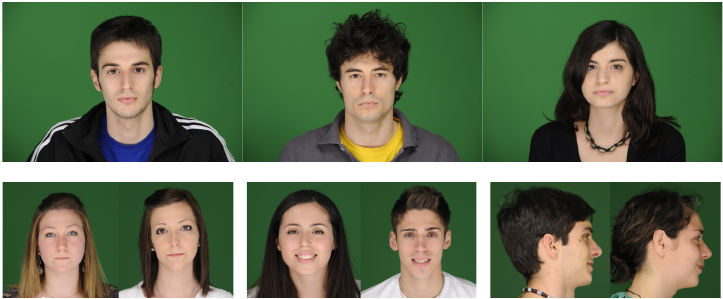

Among the information supplied by human faces to other humans in everyday life are kinship clues. Automatic kinship verification has possible applications in many areas, such as historic and genealogic research, automatic management and labeling of image databases, forensic science and finding missing family members.
Kinship verification raises a number of questions in the pattern analysis and computer vision areas, such as: which are the face features more likely to provide significant kinship clues? How effectively computerized algorithms can detect kinship? Can they outperform human judgement? The purpose of our project is to provide answers to these questions.
As a first step, we started tackling the problem of performing a comprehensive exploration of the computer identification of pairs of sibling images using several different facial features.
In order to avoid problems related to the low quality (i.e., different resolutions, orientations, illuminations and expressions) of the images used by other researchers, we constructed a dataset of high quality images specifically collected for this research. These images depict siblings in frontal and profile position, with both neutral and smiling expressions and shot in controlled lighting conditions. The dataset is available to other researchers (see details here).

Based on the lessons learned in our work on siblings, we are actually extending our to address the more challenging multi-class problem derived by other degrees of kinship, e.g. parent-child or parent-grandchild. The initial results on this ongoing work will be presented in November at the 18th Iberoamerican Conference on Pattern Recognition (CIARP – 2013).
T.F. Vieira, A. Bottino, A. Laurentini, M. De Simone
Detecting Siblings in Image Pairs
The Visual Computer, to appear, 2013 (DOI)
T.F. Vieira, A. Bottino, I. Ul Isalm
Automatic Verification of Parent-Child Pairs from Face Images
Proceedings of CIARP 2013, Havana, Cuba, 20-23 November, 2013
A. Bottino, M. De Simone, A. Laurentini, T. Vieira
A new problem in face image analysis: Finding kinship clues for siblings pairs
Proceedings of International Conference on Pattern Recognition Application and Methods, Vilamoura, Algarve, Portugal, 6-8 february 2012. pp. 153-162
Software identifica parentesco por foto
Diario de Pernambuco (Brasilian newspaper), 08.12.2013 (Article)
Copyright © 2007 - All Rights Reserved
CG&VC @ Politecnico di Torino